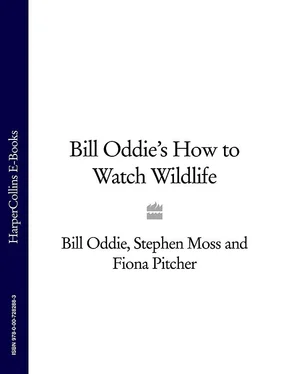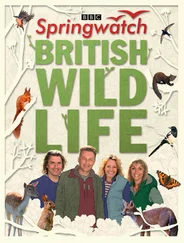Urban parks are ideal as they offer a self-contained area that you can walk round in an hour or so. Other good local patches are gravel pits, reservoirs, woods and perhaps your nearest nature reserve – anywhere you can see a good variety of wildlife at different times. Another advantage is that most places like this are already being watched by a regular visitor, who may be able to give you some tips on what you are likely to see.
By visiting a local patch once or twice a week – or even a couple of times a month – throughout the year, you’ll soon become aware of the seasonal changes, such as when birds begin to sing, or the comings and goings of migrants. Over time you’ll be amazed at how much you have actually picked up over a few months of visiting.
One way to find a local patch is to check your local Ordnance Survey map using either the 1:50,000 scale Landranger series or, better still, the larger-scale 1:25,000 Pathfinder. Look for patches of water and woodland, which are good base camps for wildlife. Or contact your regional wildlife trust or ask at your library for information on local societies or bird clubs. The library may even have an annual report on your area’s wildlife.
But before you visit, check out details of access: although many places are open to the public or have footpaths running through them, at some, a permit or permission from the owner is required to gain entry.
If you’re lucky enough to have a nature reserve in your area, here’s a bit of advice. Your first visit to a reserve can fall short of expectations. Perhaps with the memory of zoos and nature programmes from childhood, the very notion of a reserve suggests a place teeming with wildlife from dawn to dusk. Few actually deliver this. In fact, you can sometimes walk for a good 20 minutes from a reserve entrance or car park before you see anything at all. And if you go into a hide expecting to see the birds performing in front of you, well, prepare to be disappointed. However, good things do come to those who wait – and look, and listen – and come back again, and again.
B CONTENTS INTRODUCTION PART 1 GETTING STARTED WHY WATCH WILDLIFE? WATCHING WILDLIFE IN YOUR GARDEN WILDLIFE BEYOND THE GARDEN GATE KEEPING A RECORD BASIC EQUIPMENT BASIC FIELDCRAFT GETTING HELP FAMILY WILDLIFE WATCHING PART 2 THE WILDLIFE YEAR USING THIS SECTION JANUARY FEBRUARY MARCH APRIL MAY JUNE JULY AUGUST SEPTEMBER OCTOBER NOVEMBER DECEMBER PART 3 BRANCHING OUT ADVANCED EQUIPMENT JOINING UP MAKE SPACE FOR NATURE READING LIST INDEX Bill Oddie’s Acknowledgements Copyright Bill Oddie’s About the Publisher
If you’re new to watching wildlife, then the very idea of keeping notes or even a diary might seem too much like hard work. If that’s how you feel, then fine. It isn’t compulsory and, if work or family pressures mean that you don’t have all that much time to get out in the field, you might prefer to spend that time watching wildlife rather than writing about it.
On the other hand, taking a few notes of what you see doesn’t take that much extra time and has several advantages:
 Taking notes is a good way of learning about what you see: it helps you focus on how to identify what you are looking at, or to note down an interesting aspect of a creature’s behaviour.
Taking notes is a good way of learning about what you see: it helps you focus on how to identify what you are looking at, or to note down an interesting aspect of a creature’s behaviour.
 Identifying what you see is often hard to do in the field. So some people prefer to take notes as they watch the subject, then try to identify it at leisure. If you’re good at drawing, you may even want to do a quick sketch – even if you’re not, a drawing can help you pinpoint particular field marks.
Identifying what you see is often hard to do in the field. So some people prefer to take notes as they watch the subject, then try to identify it at leisure. If you’re good at drawing, you may even want to do a quick sketch – even if you’re not, a drawing can help you pinpoint particular field marks.
 Keeping a record of what you see helps you to build up a picture of what is around in your neighbourhood (or anywhere you visit), which can be helpful when you return there.
Keeping a record of what you see helps you to build up a picture of what is around in your neighbourhood (or anywhere you visit), which can be helpful when you return there.
You might also decide that you want to keep a wildlife diary; something that you write up at home after a day out at a reserve, say, or other trip. Other diaries you can keep can include the wildlife you see in your garden or at your local patch, building up a portrait of the year’s wildlife sightings. Either buy a desk diary (wait until the end of January when they are sold off at half price!), or just use a large notebook and add your own dates.
Write as much or as little as you want. Some people make long, formal lists of species, others simply jot down their memories of the day. This is your diary, so make it something you will treasure when looking back and re-reading it in years to come. Some birdwatchers have notebooks going back more than half a century, enabling them to follow their progress from early childhood to maturity and old age; a tremendously satisfying personal record.
Notebooks and diaries also have another purpose: recording the changes in your local wildlife over periods of time. As you write up your sightings from year to year, this will allow you to notice any changes that occur: such as the first date in spring you saw primroses in the nearby wood, or the last date in autumn there were house martins over your home.
_ Writing when outdoors can be difficult, especially if it’s windy or raining, or your hands are beginning to freeze. Some people take notes using a small hand-held tape recorder. It’s much easier, and you don’t have to take your eye off the creature you’re looking at.
_ One of the great joys of keeping notes is that they will bring back memories – hopefully happy ones – of days in the field. You don’t need to add loads of detail, but it is helpful to write down things that will jog your memory. So rather than writing, ‘Barn owl – 1’, why not add something to help you recall the experience, perhaps even years later? You could write, for example, ‘A barn owl flew right past us as we were walking back to the car park – a lovely sight as it went past on silent wings like a ghost’
Such simple records, kept over several decades by amateur wildlife watchers, have proved to be an unexpected asset for scientists investigating the effects of global warming on our wildlife.
Конец ознакомительного фрагмента.
Текст предоставлен ООО «ЛитРес».
Прочитайте эту книгу целиком, купив полную легальную версию на ЛитРес.
Безопасно оплатить книгу можно банковской картой Visa, MasterCard, Maestro, со счета мобильного телефона, с платежного терминала, в салоне МТС или Связной, через PayPal, WebMoney, Яндекс.Деньги, QIWI Кошелек, бонусными картами или другим удобным Вам способом.

 Taking notes is a good way of learning about what you see: it helps you focus on how to identify what you are looking at, or to note down an interesting aspect of a creature’s behaviour.
Taking notes is a good way of learning about what you see: it helps you focus on how to identify what you are looking at, or to note down an interesting aspect of a creature’s behaviour.










